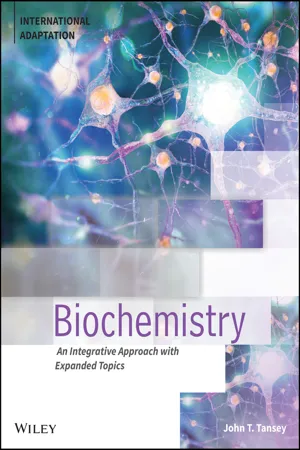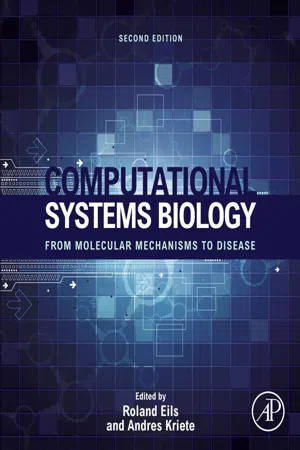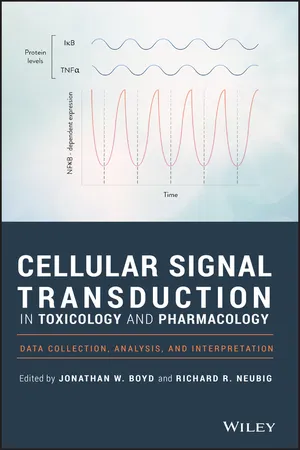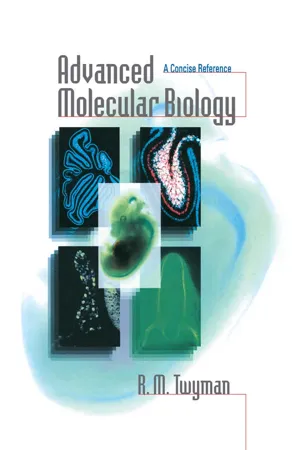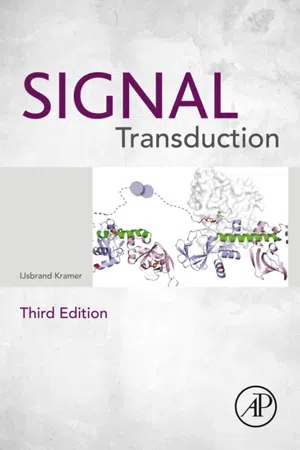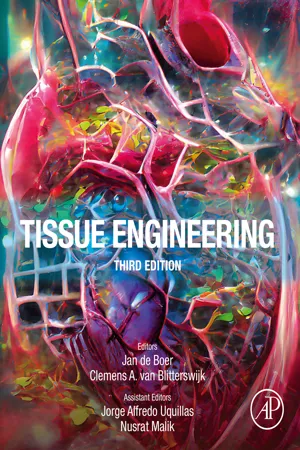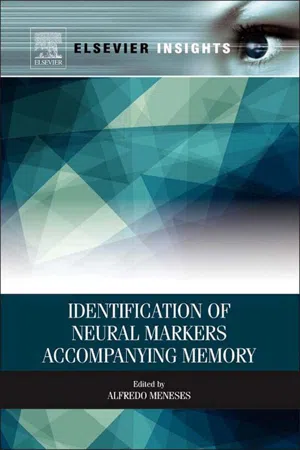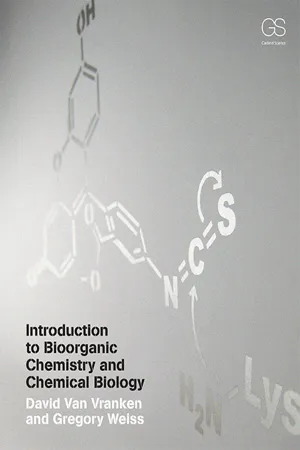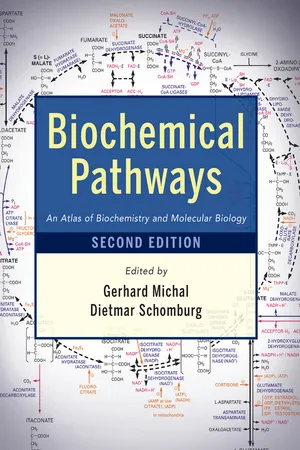Biological Sciences
Signal Transduction
Signal transduction is the process by which cells respond to external stimuli. It involves the transmission of molecular signals from the cell's exterior to its interior, leading to a specific cellular response. This complex network of signaling pathways plays a crucial role in various biological processes, including growth, development, and immune responses.
Written by Perlego with AI-assistance
Related key terms
Related key terms
1 of 4
Related key terms
1 of 3
9 Key excerpts on "Signal Transduction"
- eBook - ePub
Biochemistry
An Integrative Approach with Expanded Topics
- John T. Tansey(Author)
- 2022(Publication Date)
- Wiley(Publisher)
This chapter looks beyond regulation of enzymatic activity to examine some other facets of cell signaling, particularly in growth and dif ferentiation of cells and tissues. One of the advantages of specializing tissue function into storage (adipose), movement (muscle), and collected metabolic pathways (liver) is that an organism can have dedicated systems for these dif ferent metabolic roles. A complex organism needs to first generate these tissues and systems, then orchestrate their growth and dif ferentiation, and finally coordinate their response to dif ferent metabolic states. Collectively, all this information is significant not only in terms of basic biochemistry but also in immunology, developmental biology, and the processes involved in diseases such as cancer.21.1.1 Signal Transduction follows certain basic principlesSignal Transduction is generally accomplished through chemical signals, although some specialized cells can detect and respond to light. For communication to occur, three things need to be in place: a signal (a chemical compound released by other cells somewhere in the organism or by other organisms in the environment), a receptor for the signal, and a means by which the cell can respond (Figure 21.1 ). Signals are often hormones, and receptors are often transmembrane proteins.FIGURE 21.1 Fundamentals of Signal Transduction. In any Signal Transduction pathway, the binding of a signaling cell to a receptor initiates a cascade within the cell that ultimately results in alterations to enzyme activity or gene expression. Sometimes the signal is first propagated and amplified through a second messenger.The binding of the signal by the receptor on the extracellular side is specific, and it elicits a conformational change in the receptor that causes a change on the intracellular side of the protein. The change in the conformation typically activates enzymes such as kinases, and it can stimulate protein signaling pathways directly or be amplified by other enzymes and second messenger signaling molecules such as Ca2+ or cyclic AMP (cAMP). Recall that a second messenger - eBook - ePub
Computational Systems Biology
From Molecular Mechanisms to Disease
- Andres Kriete, Roland Eils(Authors)
- 2013(Publication Date)
- Academic Press(Publisher)
Chapter 4Biological Foundations of Signal Transduction, Systems Biology and Aberrations in Disease
Ursula Klingmüller, Marcel Schilling, Sofia Depner and Lorenza A. D’Alessandro, Division Systems Biology of Signal Transduction, German Cancer Research Center (DKFZ), Heidelberg, Germany ,E-mail: [email protected]Abstract
Cellular communication is mediated by extracellular stimuli that bind cellular receptors and activate intracellular signaling pathways. Principal biochemical reactions used for Signal Transduction are protein or lipid phosphorylation, proteolytic cleavage, protein degradation and complex formation mediated by protein-protein interactions. Within the nucleus, signaling pathways regulate transcription factor activity and gene expression. Cells differ in their competence to respond to extracellular stimuli. A deeper understanding of complex biological responses cannot be achieved by traditional approaches but requires the combination of experimental data with mathematical modeling. Following a systems biology approach, data-based mathematical models describing sub-modules of signaling pathways have been established. By combining computer simulations with experimental verification systems properties of signaling pathway including cycling behavior or threshold response could be identified. Yet, to analyze complex growth and maturation processes at a systems level and quantitatively predict the outcome of perturbations further advances in experimental and theoretical methodologies are required.Keywords
Signaling; Protein; Modeling; Dynamic; Parameter; Multiplex analysis1 Introduction
Cells do not live in isolation, but have evolved mechanisms to communicate. Principal signals used are direct cell-cell contact and secreted molecules that bind to cell surface receptors. Arrays of intracellular proteins form Signal Transduction pathways and connect to receptors. This facilitates signal transmission from the extracellular compartment to the nucleus and thereby triggering various biological responses. A key mechanism used for Signal Transduction is phosphorylation due to its simplicity, flexibility, and reversibility. In the late 1970s it was discovered that the oncogene v-Src can transform cells, possesses protein kinase activity and causes an increase in tyrosine phosphorylation (Hunter and Sefton 1980 - eBook - ePub
Cellular Signal Transduction in Toxicology and Pharmacology
Data Collection, Analysis, and Interpretation
- Jonathan W. Boyd, Richard R. Neubig(Authors)
- 2019(Publication Date)
- Wiley(Publisher)
9 Future Research in SignalingJonathan W. Boyd1 Department of Orthopaedics and Department of Physiology and Pharmacology, West Virginia University School of Medicine, Morgantown, WV, USA2 Department of Orthopaedics, West Virginia University School of Medicine, Morgantown, WV, USA3 Department of Oecotrophologie, Fulda University of Applied Sciences, Fulda, Hesse, Germany1, Nicole Prince2, and Marc Birringer3The aim of this book is to inform the reader about the intimate relationship between Signal Transduction and cellular survival/death, but the overarching goal of all mechanistic toxicology and pharmacology is to better understand both the causes of disease and potential treatments. With this goal in mind, it is important to identify areas of future research that could improve our understanding of cell signaling and serve as a bridge that better connects cellular response with disease states. There are some interesting recent studies that provide unique perspectives on Signal Transduction, which we hope will provide both insight and inspiration to further enhance our understanding of the integration of cellular signaling networks into tissues, organs, and whole organisms.9.1 Translational Research and a Spatiotemporal Understanding of Signal Transduction
For cellular Signal Transduction research to reach its potential in toxicology and pharmacology, it is necessary to bridge the gap between early responses and end disease states. Individual cells are preprogrammed with a certain amount of robustness that allows them to respond to many different types of exposures and conditions, but in a eukaryotic organism, they also possess the ability to sense and respond to a multicellular environment. Signaling responses to changes in the localized environment can lead to critical cellular bifurcations, which may result in altered processes or functions for the individual cell. The modified functions of this single cell may impact other local cells, which changes their - eBook - ePub
Advanced Molecular Biology
A Concise Reference
- Richard Twyman(Author)
- 2018(Publication Date)
- Garland Science(Publisher)
Chapter 28Signal Transduction
Fundamental concepts and definitions- Cells respond to their environment by reorganizing their structure, regulating the activity of proteins and altering patterns of gene expression. The stimulus for such responses is termed a signal, and may be a small molecule, a macromolecule or a physical agent, such as light. Signals interact with the responding cell through molecules termed receptors.
- Small molecules often act as diffusible signals. In unicellular organisms, diffusible signals may be environmental in origin or may be released from other cells (e.g. yeast mating-type pheromones, cAMP in Dictyostelium). In metazoans, signals may be released from nearby cells and diffuse over short distances (paracrine signaling), or they may be released from distant cells and reach their target through the vascular system (endocrine signaling). Macromolecular signals are often associated with the extracellular matrix or displayed on the surface of neighboring cells (juxtacrine signaling). A molecular signal that binds to a receptor is termed a ligand.
- Signals may be processed in three ways. Certain chemical signals may penetrate the plasma membrane of the cell and interact with internal receptors (e.g. steroids, nitric oxide). Most signals, however, are hydrophilic molecules remaining outside the cell. These interact with transmembrane (membrane-spanning) or membrane-associated receptors and cause a change of receptor structure. The interaction may result in signal transport, i.e. the signaling molecule is internalized (either by carriage caused by the conformation change of the receptor, by the creation of a pore, e.g. in the case of ion channels, or by receptor-mediated endocytosis). Alternatively, the conformational change in the receptor may induce enzyme activity inside the cell which mediates downstream effects while the ligand remains on the outside (Signal Transduction). Physical stimuli may also interact with receptors or may mediate their effects directly. Light stimulates the G-proteins linked to rhodopsin and cone opsin receptors when photons cause a conjugated light-sensitive molecule 11-cis retinal to change to the all-trans
- eBook - ePub
- ljsbrand M. Kramer(Author)
- 2015(Publication Date)
- Academic Press(Publisher)
Chapter 2An Introduction to Signal Transduction
Abstract
Introduction to Signal Transduction provides an overview of the many mechanisms that cells employ to create a symbolic representation of their environment. It deals with first messengers (ligands) and receptors and how they interact, their basic pharmacology, and their modes of signal transmission into the cell. It deals with transducers, effectors, and second messengers. It provides an overview of allosteric regulation and posttranslational mechanisms including methylation, acetylation, glycosylation, ubiquitinylation, sumoylation, and phosphorylation. It focuses on nucleotide exchange and GTP-binding proteins, and on protein phosphorylation, from bacteria to men, with special attention to phosphate donors and the structure and catalytic mechanisms of protein kinases and phosphatases. The distinctive role of the different signaling mechanisms is presented in the context of the most “Nobel” of signaling pathways, adrenaline-mediated activation of glycogenolysis in striated muscle (adrenoceptors, G-proteins, adenylyl cyclase, protein kinase A, phosphorylase kinase, glycogen phosphorylase). It shows how different pathways can interfere with each other (concept of signaling nodes).Keywords
First; G protein; Kinase; Messenger; Phosphatase; Posttranslational; Protein; Receptor; Second; SignalingCells need ways to create symbolic representations of their (changing) environment
A goal for the future would be to determine the extent of knowledge the cell has of itself and how it utilizes this knowledge in a “thoughtful” manner when challenged. Barbara McClintock. Nobel Prize acceptance lecture, 1983The above quote relates to homeostatic adjustments required of cells, and McClintock refers to the sensing devices that signal adjustments in the number of ribosomal DNA loci, mishaps affecting DNA, or amitotic division. We refer to this as the “signals from within,” such as those that recruit nucleotide repair machinery to the DNA or allow cells to deal with protein folding stress in the rough endoplasmic reticulum. Knowing their inner self is one thing, but cells also need to deal with their environment and this is particularly complex when they are part of an organism. Importantly, the wellbeing of the organism impacts on that of the cells and good lines of communication between the two entities are primordial. Taking this into account we can add a second scientific goal by adjusting the quote of McClintock as follows: - eBook - ePub
- Clemens van Blitterswijk, Jan De Boer(Authors)
- 2022(Publication Date)
- Academic Press(Publisher)
1 ].4.4. Signal Transduction
Cell signaling leads to biochemical changes to proteins (Fig. 4.2 ). When these changes occur to proteins that are already present in the cell, they occur quickly. However, signals that require changes in gene expression and translation of new proteins occur more slowly and often involve a more complex series of events. The complexity and specificity of signaling pathways are both largely due to the cascades they initiate. These cascades allow different ligand–receptor interactions to converge on the same pathway, or for the same ligand–receptor interaction to initiate different pathways depending on factors like the cell type or the extracellular environment.When the endpoint of signaling is transcription, the signal initiated by the ligand–receptor interaction has to be transduced from the membrane to the nucleus. Different ligand–receptor combinations can trigger different cascades of molecular interactions in the cytoplasm, resulting in the relay of the signal. In many cases, the signal is conveyed by direct protein–protein interactions and subsequent modification of target proteins, leading to their activation. For example, binding of bone morphogenetic protein 2 to its receptor leads to activation of the receptor's serine/threonine kinase activity and phosphorylation of target proteins. Phosphorylation is a common biochemical event that acts as a cellular signal. Some of the most prevalent protein modifications are summarized in Table 4.1 . Alternatively, activated proteins drive the production or relocalization of the so-called second messengers - Alfredo Meneses(Author)
- 2013(Publication Date)
- Elsevier(Publisher)
8Basic Elements of Signal Transduction Pathways Involved in Chemical Neurotransmission
Claudia González-Espinosa and Fabiola Guzmán-Mejía, Pharmacobiology Department, Center for Research and Advanced Studies (Cinvestav), South Campus, Mexico City, MéxicoDistinct process of Signal Transduction triggered in neurons by receptors to neurotransmitters and neuromodulators have been recognized as responsible for long-term changes on synapse function. Some of those biochemical modifications to the metabolism of information inside neurons are thought related to memory formation and consolidation. Basic notions of Signal Transduction are, then, necessary for the understanding of current literature and hypothesis on the neurotransmitter systems involved in prolonged alterations to neuronal function. This chapter briefly summarizes some fundamental concepts and elements of the Signal Transduction systems involved in synaptic chemical transmission.Keywords
Signal Transduction; chemical neurotransmission; G-protein-coupled receptors.Introduction
Research on cellular and molecular mechanisms involved in learning and memory constitutes a leading area in neuroscience that started long time ago. Since the mid-twentieth century, researchers have been concerned not only in finding the neurotransmitter systems involved in the transmission of electrical stimuli between nerve cells, but also in determining the long-term molecular changes that lead to long-term modifications to neural activity due to the neurotransmission process. One of the underlying hypothesis of molecular approaches to neurotransmission is that specific characteristics on the neuron-to-neuron communication (such as the intensity, duration, and composition of the signal) induce particular and sometimes irreversible modifications on neuron physiology leading to learning and memory consolidation. Description of the main neurotransmitter systems came together with the discovery of important changes in the postsynaptic terminals after the learning process. Those findings contributed to the late recognition of the importance of Signal Transduction events on the generation and maintenance of long-term changes on neural function, and allowed researchers to propose that abnormalities on particular signaling cascades could lead to modifications on the learning and memory processes.- David Van Vranken, Gregory A. Weiss(Authors)
- 2018(Publication Date)
- Garland Science(Publisher)
We have come full circle. We started this book by describing how the transcription of genes leads to all of the downstream biooligomers in the human cell. Filling in the details took up most of the book. With this chapter we have concluded our journey by describing how small molecules and macromolecules, ultimately produced by bio-oligomers, can control the transcription of other biooligomers in the cell. Moreover, we covered many examples where synthetic small molecules could be used to control Signal Transduction processes, many of which involve transcription. Biooligomers are an architectural paradigm for the efficient generation of molecular diversity—an essential ingredient in the recipe for evolution. You are now empowered to understand and control biology at the highest level of relevant detail—the level of atoms and bonds. At the level of atoms and bonds you can engineer the medicines of the future or probe the secrets of cells that make us healthy, unhealthy, and human.LEARNING OUTCOMES- Interpret the boolean logic of Signal Transduction diagrams as it applies to control of gene expression.
- Predict the effects of inhibitors and activators on Signal Transduction pathways.
- Understand the connection between Ca2+ ions and two rapid nontranscriptional processes: muscle contraction and exocytosis.
- Distinguish the seven major Signal Transduction pathways that control transcription in human cells.
- Recognize the high-affinity ligands for nuclear receptors.
- Know the three types of ligands for human two-component pathways: interleukins, interferons, and TGF-β.
- Recognize growth factors as the ligands for receptor tyrosine kinases.
- Distinguish between the four subpathways downstream of receptor tyrosine kinases: STAT, MAP kinases, PLCγ, and PI3K/Akt.
- Distinguish the death pathways (TNFα and FADD) from receptor tyrosine kinase pathways.
- Recognize the common classes of ligands that act at GPCRs.
- Distinguish between adenylyl cyclase and PLCβ pathways controlled by 7TM GPCRs.
- Recognize the imbalance between K+ , Na+ , and Ca2+ ions in human cells.
- Understand how proteolytic degradation is modulated through signaling.
- Recognize the two diffusible gases that are important in human cell signaling: NO and O2
- eBook - ePub
Biochemical Pathways
An Atlas of Biochemistry and Molecular Biology
- Gerhard Michal, Dietmar Schomburg(Authors)
- 2013(Publication Date)
- Wiley(Publisher)
cytoplasmic tyrosine kinases . Tyrosine phosphorylation can not only regulate the conformation, catalytic activity, and stability of proteins, but also serves to build modular signaling complexes by regulating protein-protein interactions. At the end of such cascades of regulatory tyrosine phosphorylation events the signal is often transferred to changes in gene expression by modulation of transcription factors (7.5).- The receptors binding steroid or thyroid hormones or retinoic acid act themselves as transcription factors (7.6). In contrast to other receptors they are not localized at the cell surface, but bind their ligands in the cytoplasm or nucleus.
- Guanylate cyclase can also be a hormone receptor. It activates various processes (7.8).
These reaction chains are interconnected in multiple ways. The general aspects of each pathway are described in Figure 7.3-1 .Figure 7.3-1 Receptors and Intracellular Transmission of Messages7.4 Receptors Coupled to Heterotrimeric G-Proteins
An essential role in Signal Transduction through the cellular membrane of animals is played by receptors, which are coupled to heterotrimeric G-proteins (Table 7.4-1 ; they are also found in plants and precursors exist even in yeast). This GPCR family comprises many hundred receptors that share the presence of seven transmembrane passes of the glycoprotein chain as a common structural feature (‘serpentine receptors ’, Fig. 7.2-6 ). Otherwise, this family shows a high degree of diversity between its members.The agonists (ligands, which specifically activate the receptor) can be small biogenic amines (e.g., histamine, 3.2.8.2 and epinephrine, 3.2.7.4) or peptides (e.g., bradykinin, 9.2.2) as well as large glycoproteins (e.g., luteinizing hormone, 7.1.5). Even light (in the visual process) can cause receptor activation (7.4.6).The stimulated receptors, in turn, activate G-proteins, which transmit the signal intracellularly via second messengers
Index pages curate the most relevant extracts from our library of academic textbooks. They’ve been created using an in-house natural language model (NLM), each adding context and meaning to key research topics.
Explore more topic indexes
Explore more topic indexes
1 of 6
Explore more topic indexes
1 of 4
